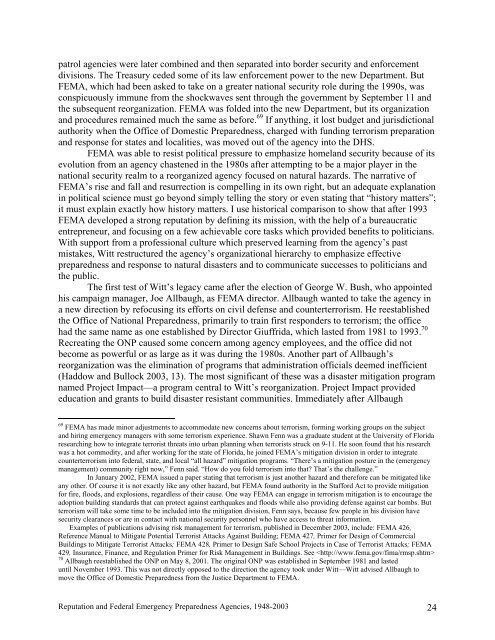Reputation and Federal Emergency Preparedness Agencies, 1948
Reputation and Federal Emergency Preparedness Agencies, 1948
Reputation and Federal Emergency Preparedness Agencies, 1948
You also want an ePaper? Increase the reach of your titles
YUMPU automatically turns print PDFs into web optimized ePapers that Google loves.
patrol agencies were later combined <strong>and</strong> then separated into border security <strong>and</strong> enforcement<br />
divisions. The Treasury ceded some of its law enforcement power to the new Department. But<br />
FEMA, which had been asked to take on a greater national security role during the 1990s, was<br />
conspicuously immune from the shockwaves sent through the government by September 11 <strong>and</strong><br />
the subsequent reorganization. FEMA was folded into the new Department, but its organization<br />
<strong>and</strong> procedures remained much the same as before. 69 If anything, it lost budget <strong>and</strong> jurisdictional<br />
authority when the Office of Domestic <strong>Preparedness</strong>, charged with funding terrorism preparation<br />
<strong>and</strong> response for states <strong>and</strong> localities, was moved out of the agency into the DHS.<br />
FEMA was able to resist political pressure to emphasize homel<strong>and</strong> security because of its<br />
evolution from an agency chastened in the 1980s after attempting to be a major player in the<br />
national security realm to a reorganized agency focused on natural hazards. The narrative of<br />
FEMA’s rise <strong>and</strong> fall <strong>and</strong> resurrection is compelling in its own right, but an adequate explanation<br />
in political science must go beyond simply telling the story or even stating that “history matters”;<br />
it must explain exactly how history matters. I use historical comparison to show that after 1993<br />
FEMA developed a strong reputation by defining its mission, with the help of a bureaucratic<br />
entrepreneur, <strong>and</strong> focusing on a few achievable core tasks which provided benefits to politicians.<br />
With support from a professional culture which preserved learning from the agency’s past<br />
mistakes, Witt restructured the agency’s organizational hierarchy to emphasize effective<br />
preparedness <strong>and</strong> response to natural disasters <strong>and</strong> to communicate successes to politicians <strong>and</strong><br />
the public.<br />
The first test of Witt’s legacy came after the election of George W. Bush, who appointed<br />
his campaign manager, Joe Allbaugh, as FEMA director. Allbaugh wanted to take the agency in<br />
a new direction by refocusing its efforts on civil defense <strong>and</strong> counterterrorism. He reestablished<br />
the Office of National <strong>Preparedness</strong>, primarily to train first responders to terrorism; the office<br />
had the same name as one established by Director Giuffrida, which lasted from 1981 to 1993. 70<br />
Recreating the ONP caused some concern among agency employees, <strong>and</strong> the office did not<br />
become as powerful or as large as it was during the 1980s. Another part of Allbaugh’s<br />
reorganization was the elimination of programs that administration officials deemed inefficient<br />
(Haddow <strong>and</strong> Bullock 2003, 13). The most significant of these was a disaster mitigation program<br />
named Project Impact—a program central to Witt’s reorganization. Project Impact provided<br />
education <strong>and</strong> grants to build disaster resistant communities. Immediately after Allbaugh<br />
69 FEMA has made minor adjustments to accommodate new concerns about terrorism, forming working groups on the subject<br />
<strong>and</strong> hiring emergency managers with some terrorism experience. Shawn Fenn was a graduate student at the University of Florida<br />
researching how to integrate terrorist threats into urban planning when terrorists struck on 9-11. He soon found that his research<br />
was a hot commodity, <strong>and</strong> after working for the state of Florida, he joined FEMA’s mitigation division in order to integrate<br />
counterterrorism into federal, state, <strong>and</strong> local “all hazard” mitigation programs. “There’s a mitigation posture in the (emergency<br />
management) community right now,” Fenn said. “How do you fold terrorism into that? That’s the challenge.”<br />
In January 2002, FEMA issued a paper stating that terrorism is just another hazard <strong>and</strong> therefore can be mitigated like<br />
any other. Of course it is not exactly like any other hazard, but FEMA found authority in the Stafford Act to provide mitigation<br />
for fire, floods, <strong>and</strong> explosions, regardless of their cause. One way FEMA can engage in terrorism mitigation is to encourage the<br />
adoption building st<strong>and</strong>ards that can protect against earthquakes <strong>and</strong> floods while also providing defense against car bombs. But<br />
terrorism will take some time to be included into the mitigation division, Fenn says, because few people in his division have<br />
security clearances or are in contact with national security personnel who have access to threat information.<br />
Examples of publications advising risk management for terrorism, published in December 2003, include: FEMA 426,<br />
Reference Manual to Mitigate Potential Terrorist Attacks Against Building; FEMA 427, Primer for Design of Commercial<br />
Buildings to Mitigate Terrorist Attacks; FEMA 428, Primer to Design Safe School Projects in Case of Terrorist Attacks; FEMA<br />
429, Insurance, Finance, <strong>and</strong> Regulation Primer for Risk Management in Buildings. See <br />
70 Allbaugh reestablished the ONP on May 8, 2001. The original ONP was established in September 1981 <strong>and</strong> lasted<br />
until November 1993. This was not directly opposed to the direction the agency took under Witt—Witt advised Allbaugh to<br />
move the Office of Domestic <strong>Preparedness</strong> from the Justice Department to FEMA.<br />
<strong>Reputation</strong> <strong>and</strong> <strong>Federal</strong> <strong>Emergency</strong> <strong>Preparedness</strong> <strong>Agencies</strong>, <strong>1948</strong>-2003 24

















